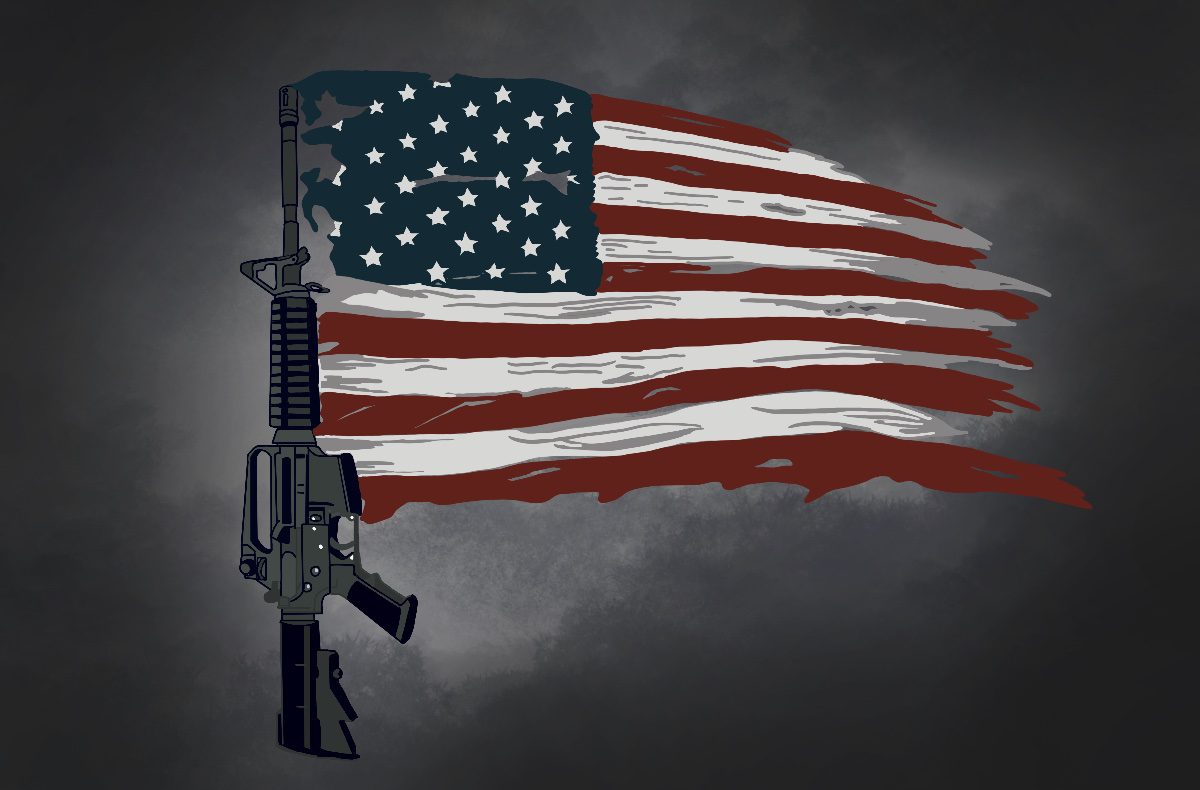
Illustration by Nikki Muller
I remember my father, the only member of his family to emigrate from Taiwan, saying that no other country had a gun culture like the United States. He said it from behind the steering wheel of our family’s Toyota Corolla, the used car that exemplified his fondness for dependable, practical things.
We were driving down the broad roadways in Phoenix, where I grew up as the only member of our family born in the U.S. It was the 1990s and, as a child, I only knew the culture of the sprawling Southwest, where—as my dad put it—people “think they are cowboys.”
Within a few years, though, my dad had a gun. He purchased a handgun along with one of his friends, another Taiwanese dad who bought a rifle. I remember them cleaning the firearms in the living rooms where we held potlucks and played Nintendo. I remember how out of place the open cases of ammo and burnished steel looked on the tables where we served fried rice and braised eggs.
The only explanation he gave was about protection—“just in case.” What was it that he imagined or feared, I wondered, that taught him to seek safety in devices designed to kill? Was it the cowboy idolatry of the American Southwest? Was it the escalation of violent attacks on Asian Americans (yes, then too), driven by anti-immigrant scapegoating? Was it the white men I’d seen shout him down in mock Chinese accents? Or was it just the decades he spent in this country where there are more guns than people?
These questions came back to me recently on the first day of the Lunar New Year, when I, along with many other Asian Americans in the United States, read the news. Eleven dead and nine wounded in a dance studio in Monterey Park. The neighborhood sits just outside of Los Angeles, six hours from where I grew up, where we regularly drove that battered Corolla to load up on Chinatown foods.
Two days after Huu Can Tran opened fire in a ballroom dance hall, Zhao Chunli killed seven people in Half Moon Bay. Many reports also tied these tragedies to the shooting at a Taiwanese church in Laguna Woods last May.
All three shooters were older men of Asian descent, a demographic often described as “invisible.”
Gun policies and Asian Americans are very rarely mentioned in the same breath and many studies omit us altogether.
Many have pointed to mental health crises nationwide and specifically within Asian American communities as central to these recent shootings. Americans do need more mental health resources, but studies show that mental illness is not a predictor of violent crimes.
People with mental illness are far more likely to be victims of violence than perpetrators, but the criminal justice system often discriminates against people with psychiatric conditions, targeting them for arrest and sentencing them to longer periods of incarceration.
Attributing mass shootings to mental illness perpetuates the unfounded stereotype that mentally ill people are innately criminal, and it neglects the root causes of gun violence. The American Psychiatric Association explains that people with serious mental illness contribute to less than 3% of gun violence incidents, and that mass murders are more often tied to complex interactions of emotional turmoil, traumatic life events, and access to guns and victims. In other words, preventing mass shootings requires addressing causes of social trauma—including racism and other forms of social discrimination—and lax gun regulations. It requires alleviating poverty and income inequality, and funding culturally-competent programs for public services.
With Asian Americans getting shoved onto subway tracks, beaten in their apartment buildings, and stabbed on buses, the firearms industry tried to capitalize on the fear provoked by these attacks. Pro-gun lobbyists cited examples of extreme violence as a reason Asian Americans should own guns, and Asian Americans purchased guns at record rates amid the rise of anti-Asian violence. A recent study found that those who experienced racist aggression were more likely to buy firearms.
Contrary to some assertions, though, research has found that those who live with a gun owner are at significantly higher risk of dying by homicide. Another recent study showed that states with more permissive gun laws and more gun owners had more mass shootings.
It’s dangerous to isolate any single cause for these different, horrific events that continue to impact communities across the country. Many families also need time and space to grieve. But all Americans deserve urgent responses to the full-fledged crisis of gun violence. There have already been 48 mass shootings in the first month of 2023.
Research consistently shows that the proverbial “good guy with a gun” will not improve public safety. Instead, politicians and community leaders can advocate for evidence-based solutions, such as community violence interventions, restrictions on public carry, repeals of “stand your ground” laws, and tighter regulations on the sales and storage of firearms. Public officials and administrators can also invest in more research into gun violence prevention.
As for my dad—he stopped going to the shooting range after a few months. He and his friend went back to playing tennis, and we kids reclaimed the living room to play Tetris and Mario Kart. I haven’t seen the gun in two decades.
The world has not gotten any safer in that time, but there are limitations to the comfort one can find behind a trigger.
